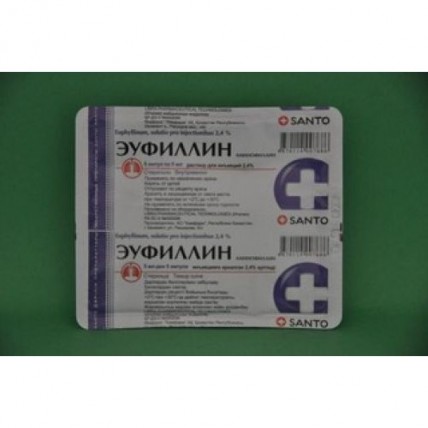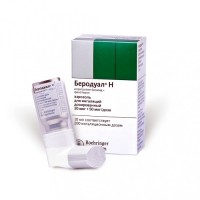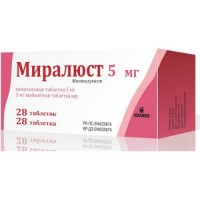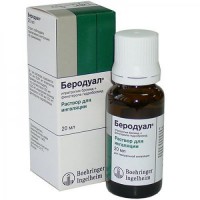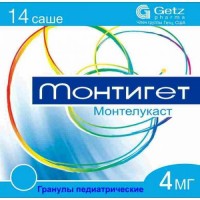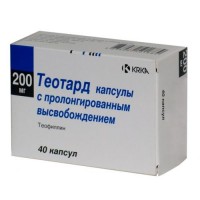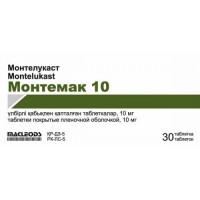Euphyllin (Aminophylline) 2.4%/5 ml, 5 ampoules
- $6.00
The instruction for medical use
of medicine
Euphyllinum
the Trade name
MNN Euphyllinum
Aminophyllinum
the International unlicensed
name Aminophyllinum Dosage Form Solution for injections of 2.4% 5 ml
Structure
of 5 ml of solution contain
active agent - Aminophyllinum (in terms of dry matter) 120.0 mg,
excipient - water for injections.
The description
Transparent, colourless or with a weak yellowish shade liquid.
Pharmacotherapeutic group
Other drugs for treatment of respiratory diseases for system use. Xanthines.
The code of automatic telephone exchange R03DA05
the Pharmacological
Pharmacokinetics Bioavailability properties - 90-100%. Time of achievement of the maximum concentration in blood plasma at intravenous administration of 0.3 g - 15 min., the maximum concentration in blood plasma - 7 mkg/ml. The volume of distribution there are in the range of 0.3-0.7 l/kg (30-70% of ideal body weight), on average 0.45 l/kg. Communication with proteins of plasma adults - 60%, at newborns have 36%, at patients with cirrhosis - 36%. Gets into breast milk (10% of the accepted dose), through a placental barrier (concentration in blood serum of a fruit is slightly higher, than in mother's serum).
Bronkhodilatiruyushchy properties Aminophyllinum shows 10-20 mkg/ml in concentration. Concentration over 20 mg/ml is toxic. The exciting effect on a respiratory center is implemented at lower content of drug in blood - 5-10 mkg/ml.
It is metabolized in a liver with the participation of several isoenzymes of P450 cytochrome and in the form of metabolites it is removed with urine. In not changed look at adults 10% are removed. At newborns a considerable part is removed in the form of caffeine (because of immaturity of ways of his further metabolism), in not changed look – 50%.
Elimination half-life at non-smoking patients with bronchial asthma makes 6-12 hours, smokers have 4-5 hours, children have 1-5 hours, at newborn and premature – 10-45 hours. Elimination half-life increases at elderly people and at patients with heart failure or diseases of a liver.
The pharmacodynamics
Euphyllinum renders spasmolytic, vazodilatiruyushchy, bronkhodilatiruyushchy, diuretic action.
Effect of Euphyllinum is caused, the theophylline which is contained in it and ethylene diamine. Inhibits phosphodiesterase (etilendiaminovy salt of theophylline), causes relaxation of smooth muscles of bronchial tubes, coronary, cerebral and pulmonary vessels, digestive tract, biliary tract, increases contractility of skeletal muscles (including respiratory). Activates a respiratory center of a medulla, increases its sensitivity to carbon dioxide. Euphyllinum can cause temporary strengthening of a diuresis, increase secretion of acid in a stomach, slow down aggregation of thrombocytes.
Indications
- bronchial asthma, a bronchospasm of various etiology (generally for
stopping of attacks)
- left ventricular nedostatochnogst with a bronchospasm and disturbance
of breath as Cheyn-Stokes
- chronic heart failure (as a part of combination
therapy)
- the ischemic stroke and chronic insufficiency of cerebral
circulation (as a part of combination therapy)
Intravenously Adult enter the Route of administration and doses slowly on 240 – 480 mg (10-20 ml of 2.4% of solution) which part previously in 10-20 ml of isotonic solution of sodium of chloride.
At emergence of heartbeat, dizziness, nausea reduces rate of administering or passes to drop introduction for what 10-20 ml of 2.4% of solution part in 100-150 ml of isotonic solution of sodium of chloride, enters with a speed of 30-50 thaws a minute.
Parenterally enter up to 3 times a day no more than 14 days.
The maximum single dose for adults – 250 mg, daily – 200 mg.
Use in pediatrics
to Children up to 14 years do not recommend to appoint drug because of possible by-effects.
In need of administration of drug according to vital indications to children enter intravenously in a single dose 2-3 mg/kg.
In an apnoea of newborns the initial dose makes 5 mg/kg (it is entered on the nazogastralny probe), a maintenance dose — 2 mg/kg, in 2 receptions.
The maximum single dose for children intravenously – 3 mg/kg.
Side effects
Often
- dizziness, a headache, insomnia, excitement, uneasiness, irritability, a tremor, the increased sweating
Is rare
- nausea, vomiting, a gastroesophageal reflux, heartburn, exacerbation of a peptic ulcer, diarrhea, at long reception - a loss of appetite
- skin rash, an itching of skin, fever, feeling of inflows to the person
- a hypoglycemia, strengthening of a diuresis is Very rare
- tachycardia (including at a fruit during administration of drug of the pregnant woman in the III trimester), arrhythmias, a lowering of arterial pressure, a cardialgia, increase in frequency of attacks of stenocardia, a stethalgia, a tachypnea, an albuminuria, gematuriyapobochny effects decrease at a drug dose decline. Local reactions: consolidation, hyperaemia, morbidity in the injection site.
Contraindications
- hypersensitivity to Euphyllinum and theophylline
- expressed arterial hypo - and hypertensia
- an acute heart failure
- an acute period of a myocardial infarction
- a Bouveret's disease, premature ventricular contraction, a tachyarrhythmia
- a peptic ulcer of a stomach and duodenum in an aggravation phase
- heavy abnormal liver functions and/or kidneys
- epilepsy
- alcoholism
- a hyper thyroidism, a hypernatremia
- the lactation period
- a hemorrhagic stroke
- an eye retinal apoplexy
- the children's age up to 14 years
Medicinal interactions
At simultaneous use happens to sympathomimetics mutual strengthening of action, with beta blockers and drugs of lithium – action mutually decreases.
The intensity of effect of Euphyllinum can decrease (owing to increase in its clearance) at simultaneous use with phenobarbital, rifampicin, an isoniazid, carbamazepine, Sulfinpyrazonum, Phenytoinum and also at smokers.
The intensity of effect of Euphyllinum can increase (owing to increase in its clearance) at simultaneous use with antibiotics from group of macroleads, lincomycin, with hinolona, Allopyrinolum, beta blockers, Cimetidinum, fluvoksaminy, hormonal contraceptives for intake, izoprenaliny, viloksaziny and at vaccination against flu.
Derivatives of xanthine can exponentiate the hypopotassemia caused by action of stimulators β2-адренорецепторов, corticosteroids and diuretics.
Raises a likelihood of development of side effects of glucocorticoids, mineralokortikoid (hypernatremia), anesthetics (the risk of developing of ventricular arrhythmias increases).
Reduces specific activity of salts of lithium.
Special instructions
Intravenous administration has to be carried out under careful control of blood circulation, breath and the general condition of the patient (ChSS, the ABP, number of dykhaniye).
It is not recommended to apply in widespread atherosclerosis. Correction of the mode of dosing of Euphyllinum can be required in heart failure, abnormal liver functions, fever, acute respiratory diseases. At patients of advanced age the reduction of a dose can be required. When replacing of the applied dosage form of Euphyllinum by another the clinical observation and control of concentration of theophylline in blood plasma is necessary. Euphyllinum is not applied along with other derivatives of xanthine. During treatment it is necessary to avoid consumption of the foodstuff containing xanthine derivatives (strong coffee, tea). With care apply along with anticoagulants, with other derivatives of theophylline or purine.
It is necessary to avoid simultaneous use with beta blockers. Not to apply rektalno at children.
Pregnancy and the period of a lactation
Euphyllinum gets through a placental barrier. Use of Euphyllinum at pregnancy can lead to creation of potentially dangerous concentration of theophylline and caffeine in blood plasma of the newborn. Newborns whose mothers at pregnancy received Euphyllinum (especially in the III trimester) need medical observation for control of possible symptoms of intoxication of theophylline. Theophylline is emitted with breast milk. Use of Euphyllinum at pregnancy is possible in cases when the expected advantage of therapy for mother exceeds potential risk for a fruit or the child.
Features of influence of medicine not ability to run the vehicle or potentially dangerous mechanisms
Considering side effects of medicine it is necessary to apply with care in operating time to drivers of vehicles and people whose profession is connected with the increased concentration of attention.
Overdose
Symptoms: anorexia, diarrhea, nausea, vomiting, pains in epigastric area, gastrointestinal bleeding, a tachypnea, hyperaemia of the person, tachycardia, ventricular arrhythmias, insomnia, concern, a photophobia, generalized spasms.
Treatment: drug withdrawal, stimulation of its removal from an organism (artificial diuresis, hemosorption, plazmosorbtion, hemodialysis, peritoneal dialysis), symptomatic therapy.
A form of release and packing
On 5 ml in ampoules.
On 5 ampoules pack into blister strip packaging from a film of polyvinylchloride and aluminum foil. Put the scarificator in each planimetric packing ampoule.
Planimetric packings place in a box of cardboard. The iinstruktion on medical use in the state and Russian languages invests in a box.
To Store storage conditions in the place protected from light, at a temperature not above 30 °C.
To store out of children's reach!
3 years
not to apply a period of storage after an expiration date.
Prescription status
According to the prescription
JSC Khimfarm Producer,
REPUBLIC OF KAZAKHSTAN, Shymkent, Rashidov St.,/N, ph.: 561342
The address of the organization accepting in the territory of the Republic of Kazakhstan claims from consumers on quality of products (goods) of JSC Khimfarm, Shymkent, REPUBLIC OF KAZAKHSTAN, Rashidov St.,/N, ph.: 560882 Phone number 7252 (561342) Fax number 7252 (561342)
to Develop the E-mail address of standart@santo.kz
of medicine
Euphyllinum
the Trade name
MNN Euphyllinum
Aminophyllinum
the International unlicensed
name Aminophyllinum Dosage Form Solution for injections of 2.4% 5 ml
Structure
of 5 ml of solution contain
active agent - Aminophyllinum (in terms of dry matter) 120.0 mg,
excipient - water for injections.
The description
Transparent, colourless or with a weak yellowish shade liquid.
Pharmacotherapeutic group
Other drugs for treatment of respiratory diseases for system use. Xanthines.
The code of automatic telephone exchange R03DA05
the Pharmacological
Pharmacokinetics Bioavailability properties - 90-100%. Time of achievement of the maximum concentration in blood plasma at intravenous administration of 0.3 g - 15 min., the maximum concentration in blood plasma - 7 mkg/ml. The volume of distribution there are in the range of 0.3-0.7 l/kg (30-70% of ideal body weight), on average 0.45 l/kg. Communication with proteins of plasma adults - 60%, at newborns have 36%, at patients with cirrhosis - 36%. Gets into breast milk (10% of the accepted dose), through a placental barrier (concentration in blood serum of a fruit is slightly higher, than in mother's serum).
Bronkhodilatiruyushchy properties Aminophyllinum shows 10-20 mkg/ml in concentration. Concentration over 20 mg/ml is toxic. The exciting effect on a respiratory center is implemented at lower content of drug in blood - 5-10 mkg/ml.
It is metabolized in a liver with the participation of several isoenzymes of P450 cytochrome and in the form of metabolites it is removed with urine. In not changed look at adults 10% are removed. At newborns a considerable part is removed in the form of caffeine (because of immaturity of ways of his further metabolism), in not changed look – 50%.
Elimination half-life at non-smoking patients with bronchial asthma makes 6-12 hours, smokers have 4-5 hours, children have 1-5 hours, at newborn and premature – 10-45 hours. Elimination half-life increases at elderly people and at patients with heart failure or diseases of a liver.
The pharmacodynamics
Euphyllinum renders spasmolytic, vazodilatiruyushchy, bronkhodilatiruyushchy, diuretic action.
Effect of Euphyllinum is caused, the theophylline which is contained in it and ethylene diamine. Inhibits phosphodiesterase (etilendiaminovy salt of theophylline), causes relaxation of smooth muscles of bronchial tubes, coronary, cerebral and pulmonary vessels, digestive tract, biliary tract, increases contractility of skeletal muscles (including respiratory). Activates a respiratory center of a medulla, increases its sensitivity to carbon dioxide. Euphyllinum can cause temporary strengthening of a diuresis, increase secretion of acid in a stomach, slow down aggregation of thrombocytes.
Indications
- bronchial asthma, a bronchospasm of various etiology (generally for
stopping of attacks)
- left ventricular nedostatochnogst with a bronchospasm and disturbance
of breath as Cheyn-Stokes
- chronic heart failure (as a part of combination
therapy)
- the ischemic stroke and chronic insufficiency of cerebral
circulation (as a part of combination therapy)
Intravenously Adult enter the Route of administration and doses slowly on 240 – 480 mg (10-20 ml of 2.4% of solution) which part previously in 10-20 ml of isotonic solution of sodium of chloride.
At emergence of heartbeat, dizziness, nausea reduces rate of administering or passes to drop introduction for what 10-20 ml of 2.4% of solution part in 100-150 ml of isotonic solution of sodium of chloride, enters with a speed of 30-50 thaws a minute.
Parenterally enter up to 3 times a day no more than 14 days.
The maximum single dose for adults – 250 mg, daily – 200 mg.
Use in pediatrics
to Children up to 14 years do not recommend to appoint drug because of possible by-effects.
In need of administration of drug according to vital indications to children enter intravenously in a single dose 2-3 mg/kg.
In an apnoea of newborns the initial dose makes 5 mg/kg (it is entered on the nazogastralny probe), a maintenance dose — 2 mg/kg, in 2 receptions.
The maximum single dose for children intravenously – 3 mg/kg.
Side effects
Often
- dizziness, a headache, insomnia, excitement, uneasiness, irritability, a tremor, the increased sweating
Is rare
- nausea, vomiting, a gastroesophageal reflux, heartburn, exacerbation of a peptic ulcer, diarrhea, at long reception - a loss of appetite
- skin rash, an itching of skin, fever, feeling of inflows to the person
- a hypoglycemia, strengthening of a diuresis is Very rare
- tachycardia (including at a fruit during administration of drug of the pregnant woman in the III trimester), arrhythmias, a lowering of arterial pressure, a cardialgia, increase in frequency of attacks of stenocardia, a stethalgia, a tachypnea, an albuminuria, gematuriyapobochny effects decrease at a drug dose decline. Local reactions: consolidation, hyperaemia, morbidity in the injection site.
Contraindications
- hypersensitivity to Euphyllinum and theophylline
- expressed arterial hypo - and hypertensia
- an acute heart failure
- an acute period of a myocardial infarction
- a Bouveret's disease, premature ventricular contraction, a tachyarrhythmia
- a peptic ulcer of a stomach and duodenum in an aggravation phase
- heavy abnormal liver functions and/or kidneys
- epilepsy
- alcoholism
- a hyper thyroidism, a hypernatremia
- the lactation period
- a hemorrhagic stroke
- an eye retinal apoplexy
- the children's age up to 14 years
Medicinal interactions
At simultaneous use happens to sympathomimetics mutual strengthening of action, with beta blockers and drugs of lithium – action mutually decreases.
The intensity of effect of Euphyllinum can decrease (owing to increase in its clearance) at simultaneous use with phenobarbital, rifampicin, an isoniazid, carbamazepine, Sulfinpyrazonum, Phenytoinum and also at smokers.
The intensity of effect of Euphyllinum can increase (owing to increase in its clearance) at simultaneous use with antibiotics from group of macroleads, lincomycin, with hinolona, Allopyrinolum, beta blockers, Cimetidinum, fluvoksaminy, hormonal contraceptives for intake, izoprenaliny, viloksaziny and at vaccination against flu.
Derivatives of xanthine can exponentiate the hypopotassemia caused by action of stimulators β2-адренорецепторов, corticosteroids and diuretics.
Raises a likelihood of development of side effects of glucocorticoids, mineralokortikoid (hypernatremia), anesthetics (the risk of developing of ventricular arrhythmias increases).
Reduces specific activity of salts of lithium.
Special instructions
Intravenous administration has to be carried out under careful control of blood circulation, breath and the general condition of the patient (ChSS, the ABP, number of dykhaniye).
It is not recommended to apply in widespread atherosclerosis. Correction of the mode of dosing of Euphyllinum can be required in heart failure, abnormal liver functions, fever, acute respiratory diseases. At patients of advanced age the reduction of a dose can be required. When replacing of the applied dosage form of Euphyllinum by another the clinical observation and control of concentration of theophylline in blood plasma is necessary. Euphyllinum is not applied along with other derivatives of xanthine. During treatment it is necessary to avoid consumption of the foodstuff containing xanthine derivatives (strong coffee, tea). With care apply along with anticoagulants, with other derivatives of theophylline or purine.
It is necessary to avoid simultaneous use with beta blockers. Not to apply rektalno at children.
Pregnancy and the period of a lactation
Euphyllinum gets through a placental barrier. Use of Euphyllinum at pregnancy can lead to creation of potentially dangerous concentration of theophylline and caffeine in blood plasma of the newborn. Newborns whose mothers at pregnancy received Euphyllinum (especially in the III trimester) need medical observation for control of possible symptoms of intoxication of theophylline. Theophylline is emitted with breast milk. Use of Euphyllinum at pregnancy is possible in cases when the expected advantage of therapy for mother exceeds potential risk for a fruit or the child.
Features of influence of medicine not ability to run the vehicle or potentially dangerous mechanisms
Considering side effects of medicine it is necessary to apply with care in operating time to drivers of vehicles and people whose profession is connected with the increased concentration of attention.
Overdose
Symptoms: anorexia, diarrhea, nausea, vomiting, pains in epigastric area, gastrointestinal bleeding, a tachypnea, hyperaemia of the person, tachycardia, ventricular arrhythmias, insomnia, concern, a photophobia, generalized spasms.
Treatment: drug withdrawal, stimulation of its removal from an organism (artificial diuresis, hemosorption, plazmosorbtion, hemodialysis, peritoneal dialysis), symptomatic therapy.
A form of release and packing
On 5 ml in ampoules.
On 5 ampoules pack into blister strip packaging from a film of polyvinylchloride and aluminum foil. Put the scarificator in each planimetric packing ampoule.
Planimetric packings place in a box of cardboard. The iinstruktion on medical use in the state and Russian languages invests in a box.
To Store storage conditions in the place protected from light, at a temperature not above 30 °C.
To store out of children's reach!
3 years
not to apply a period of storage after an expiration date.
Prescription status
According to the prescription
JSC Khimfarm Producer,
REPUBLIC OF KAZAKHSTAN, Shymkent, Rashidov St.,/N, ph.: 561342
The address of the organization accepting in the territory of the Republic of Kazakhstan claims from consumers on quality of products (goods) of JSC Khimfarm, Shymkent, REPUBLIC OF KAZAKHSTAN, Rashidov St.,/N, ph.: 560882 Phone number 7252 (561342) Fax number 7252 (561342)
to Develop the E-mail address of standart@santo.kz
